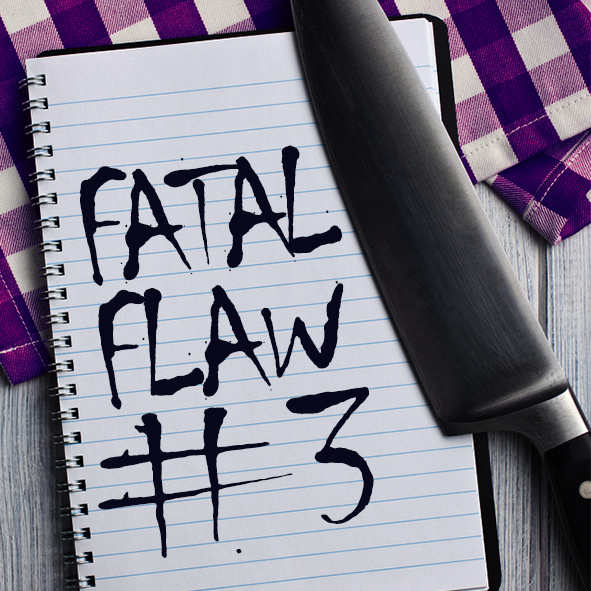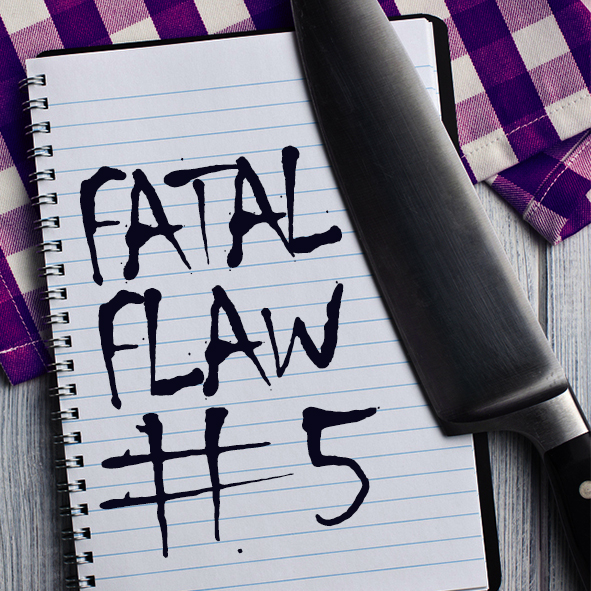Keeping It Real—Avoiding Weak Construction in Dialog
This month we’ve been tackling Fatal Flaw #3: Weak Construction. Our editors have so far shown many ways our writing can come across as weak, including the use of boring, flat, or vague words and descriptions. Weak sentence structure plagues many manuscripts, but knowing how to spot these flaws, and how to correct them, is not all that hard. Today, editor Christy Distler dives deeper into the topic by examining what constitutes weak construction in dialog.
We’ve been talking about weak writing with the Wednesday posts this month, and today we’re going to look at dialog. Strong dialog is crucial. In fact, according to a literary agent I met at a writers’ conference this last summer, it’s one of the first things an agent evaluates when reading a manuscript.
Why? Because dialog gives a quick yet solid indication of a writer’s abilities. It conveys how much a writer has studied the craft and how well he or she understands the mechanics of speech.
Strong dialog keeps a story interesting by revealing characters’ traits, advancing the plot, and breaking up narrative with action that clearly describes what’s happening. Conversely, weak dialog results in shallow characters with no individuality, a dragging plot, and an ambiguous, unsatisfying story. Even the best plot lines won’t hold a reader’s interest if the writer lacks the ability to create good dialog.
Now there’s no way we could go into all the aspects of good and bad dialog in one post (but we will cover them in a series of several posts later this year, so stay tuned!). In this post, we’ll delve into weak dialog construction—namely, keeping it real, keeping it transparent, and keeping it understandable.
Consider this Before excerpt:
BEFORE:
Moments later, Mother, Daddy, and I sat down on leather chairs in the headmaster’s office.
“Mr. and Mrs. Miller. Cassandra,” he began slowly. “Welcome to Covington Hall.”
“Thank you, Mr. Smith,” she answered primly. “We are happy to be here.”
“Yes. We believe this is the best school for Cassie,” he confirmed.
“Indeed. Cassandra has always been an excellent student,” she added quickly. “She is looking forward to being a student here at Covington Hall.”
“And we are looking forward to having her as a student here,” he agreed.
“Yes. She will fit in well with the other students here,” she assured us. “We have several students here who have well-above-average intelligence but have made poor decisions. I am happy to say that these students have excelled and showed exemplary behavior here at Covington.”
“And that is what we want for her,” she said. “A new start.”
I crossed my arms and let my breath out without making a sound. Apparently, no one thought it was in any way important to ask what I wanted.
So what are your first thoughts?
Mine? Blah blah blah. Everybody sounds the same (like a monotone robot)—and who’s saying what? Besides Cassandra, there are two men and two women in the room. While readers might be able to decipher who’s speaking by what’s said, if they need to make an effort to figure it out, they’re going to give up on the story. Then there’s the Talking Head Syndrome going on (all talking, no action). Finally, the use of superfluous dialog tags and adverbs ending in ly seriously bog down the reading. Few readers are going to stick it out through this version of the story; reading isn’t supposed to be so complicated yet boring that it hurts.
Now let’s check out a rewrite:
AFTER:
Moments later, Mother, Daddy, and I sat down on leather chairs in the headmaster’s office.
Headmaster Smith observed me with his tiny eyes and pointed nose, reminding me of a gaunt, balding mole. He then nodded at Mother and Daddy. “Mr. and Mrs. Miller. Cassandra. Welcome to Covington Hall.”
“Thank you, Mr. Smith,” Mother said. Even without looking at her, I could tell she wore a sickening-sweet smile. “We’re happy to be here.”
Daddy took my hand in his. “We truly believe this is the best school for Cassie.”
“Cassandra has always been an excellent student.” Mother rested her gaze on me and snapped her shoulders back. When I followed her cue and sat up straighter, she returned her attention to Headmaster Mole. “She’s looking forward to being a student here at Covington Hall.”
Ms. Willingham, the headmaster’s tall assistant, clasped her hands at her narrow waist as she stood behind him. She attempted a thin-lipped smile, although it looked more like she’d just sucked a lemon. “Cassandra should fit in quite nicely here. We have several students with well-above-average intelligence who have simply made poor decisions. I’m happy to say these students have excelled and showed exemplary behavior here at Covington Hall.”
Mother beamed at them. “That’s exactly what we want for her. A new start.”
I let my breath out without making a sound. Apparently, no one thought it was in any way important to ask what I wanted.
What’s different this time? Um, well . . . everything. Here’s a list:
- Action accompanies the dialog. The characters are actually doing things, not just speaking—and in their described actions, we get a much better idea of who the characters are, physically and personally. Action moves the story forward.
- The dialog isn’t stilted and monotone. Contractions are used where appropriate, and the characters don’t all sound the same (although it’s hard to fully gauge that in such a short passage). Just like real people, characters are all different—their “voices” should reflect that.
- It’s obvious who’s speaking. Instead of using the vague pronouns he and she, both of which could indicate more than one of the characters, names are given. A scene with two characters generally requires only sporadic use of names, but a scene with multiple speakers quickly becomes confusing if the author doesn’t delineate who’s speaking. Make it clear who’s saying what. (This is a great place to tout the awesomeness of critique partners. While a writer knows which of their characters are saying what, a crit partner will point out any places where dialog—and any other aspect of the story—is ambiguous. Love crit partners!)
- Finally, the story flows so much better without the repeated dialog tags and adverbs ending in ly. Nowadays, most editors recommend said as the dialog tag of choice (if a tag is necessary—many times they’re not since action or other dialog makes it clear who’s speaking). That doesn’t mean writers should never use other tags, but most readers skim over said. This keeps the dialog transparent by allowing the reader to concentrate on what’s being said instead of how it’s being said. Along the same line, omitting the ly adverbs supports transparency in the same way and also encourages the writer to show emotion through dialog and action instead of telling it with words.
Learning to write strong dialog takes work, but it’s so worth the effort that goes into it. The advice I give writers who are struggling with dialog is to mindfully listen to how people speak in everyday situations and to read dialog after it’s been written. Then evaluate. Does it sound natural or stilted? Do characters have their own voice? Does it flow well and sound transparent, or do dialog tags and adverbs bog it down? Does it complement the action, and does the action complement it?
Then, rewrite as necessary—and love the stronger dialog that results.
Your turn:
Do you find dialog easier or harder to write than narrative? What other advice about writing dialog have you found helpful? Let’s get the dialog going (ack, sorry, couldn’t resist!).










The biggest difference for me in your before and after is that Cassie basically drops out of the before passage. She’s in the first and last lines, but she has no reaction to what’s going on around her. In the second, the characterizations of those speaking and her reactions to what they’re saying tell us a lot about her as well as the speakers.
I like writing dialogue, but I usually try to get the actual spoken words themselves right, then go back and add in actions, description, interior monologue to deepen the scene.
Exactly, Sara! We’re not seeing Cassie in the BEFORE passage, and that’s crucial. We write similarly. I often focus on dialogue and blatant descriptions and actions in the first draft, then add to that when I rewrite/edit. 🙂
Thanks for stopping by!
Great example of how to fix weak dialog. I much prefer the second, where we see Cassandra’s reactions to what’s being said. And her descriptions of the headmaster and his assistant are organic to the scene, so we hardly realize they’re also action beats that tell us who’s speaking. The way the mother looked at her and made her straighten her shoulders–that’s excellent. It gives us a glimpse into what’s important for mom and a glimpse into their relationship. Well done.
Thanks, Robin. The BEFORE example even confuses me, and I wrote it.
Glad you stopped by!
I found this excellent. I will benefit from your examples of how to show who is talking in a group without repetitive “he said, she said”, by having characters doing something as they speak. This also allows character trait development.
I need a critique partner. Looking for someone who needs same. I am on circa thirty five thousand words of first crime fiction novel.
Let me know if any visitor here needs a critique partner.
John
johnwtoneill@gmail.com
Thank you, John. The “said” tag certainly has its place, but action beats are a great way to keep them to a minimum—and you’re spot on about the character trait development.
Thanks for stopping by!
Hi, John.
How do you feel about fantasy? I have a finished first draft of two novels from a three part series that I’m planning to edit soon and a separate fantasy work-in-progress that’s also somewhere at thirty five to forty thousand words.
Hi John – I liked your response to the Before and After samples. I also need a critique partner. I am not writing crime fiction other than bits and pieces in a cozy mystery with a bit of romance. I would be willing to read a piece of your ms if you would do likewise.
Sincerely,
Patricia
The one thing I noticed in both the passages is the repetition of referencing “Covington Hall.” In such a short passage, wouldn’t once be enough to tell the reader the school name? The second one is much better than the first however.
I would be interested in a critique partner as well. So John O’Neill, I will send you an email. 🙂
🙂 I wondered if anyone would mention the repetition of that. I did that on purpose, mainly in the AFTER, because this scene (to some extent) was actually taken from a real-life experience. The administrators kept repeating the school name, and I thought it was funny. So, no, the repetition *isn’t* necessary (and most editors would recommend nixing it unless it has a real purpose).
Glad you stopped by!
email received and replied to. Thanks so much.
This article was very helpful and provided an excellent demonstration of action centered dialog. All characters come to life in the second example. Thank you!
Thank you, Stinson! Glad you dropped by.
I’m always struggling with what to have the characters do while they’re speaking. If it’s a longer dialogue, for example, and they’re just sitting and talking, after a while it gets really hard to find something for them to DO, that isn’t just running hands through their hair or similar empty movements. I often put the dialogue down first, then come back and add the action, but it usually takes me several edits to add it all because I run out of things for them to do, if it’s a very still scene.
Personally, I’m not a big fan of “said” because it doesn’t really tell you anything. The very quotes are telling you that someone said something. But it is invisible, so it does have that advantage. I use it if it’s not clear who’s speaking and I can’t add any meaningful action tags, but if it’s clear who’s talking, I’d sooner leave just the quotes. There’s nothing wrong with just the dialogue quotes standing on their own every so often. But I like to vary it, use a bit of action tags, a bit of said, a bit of those said replacements like ask and answer, even a bit of -ly sparingly, so that there’s nothing that stands out that might draw attention to itself. The more things you use, the smaller the chance you’ll end up repeating them. You have only one said in the after example yourself (and it really belongs there), so we probably have similar preferences :).
I love the added characterisation in the after example. Dialogues also offer great opportunity to sneak in some character description.
Great insights, Catie. The “sitting and talking” scene can be tough one to keep “active.” The dialogue needs to be interesting enough to keep the reader’s attention, and then there needs to be some other interaction so you don’t feel like the characters are just talking heads. Obviously it’s best to keep these scenes to a minimum, but sometimes they’re necessary and they can be captivating if the discussion has plenty of tension (either internal or external) to it.
Years ago, an instructor at a writer’s conference pointed out that on TV shows, characters almost always have something in their hand (a drink, a book, whatever). She recommended the same for book characters, so they have something to do besides just talk if the scene is less physically active.
Thanks for stopping by!
And they’re always walking and talking! I try to do that as much as possible, but sometimes the scene is just not suitable for it. That’s when I have to be really creative.
Thank you for the great post. I have just put the finishing touches on my novel in which I have used a great deal of dialogue. Much of what you have shared I have learned in our writer’s group over the past few years, and put it to good use in my book. I like your “After” much better than the “Before” as it flows well and also paints a word picture so we can “see” the characters. When I read, I automatically picture the scenes, and become bored if the author fails to make me “see” the story.
I enjoy creating dialogue. Catie said she sometimes runs out of ideas of what to have her characters do when the dialogue is long. Depending on the topic, I sometimes have the speaker pause to think about the past to leave a place for “silence” in the dialogue. At times I will have one of the speakers get up to make a cup of tea to break up any possible monotony, or have the speaker pick up a cookie to take a bite. I may have them make a comment on the tea, etc. to make a bit of a break in the story they are telling. If it is a sad tale, I have the speaker stop to dry their eyes, or have the listener put her arm around her friend. There are many options to keep a long dialogue from becoming boring. I think the clearer we can picture and “hear” our characters the easier it is to write in an interesting way.
Thanks for the tips! We really need to be creative sometimes to keep the action rolling. In the story I’m currently writing, I have the characters eating dinner during one of those long conversation. I had them chewing, cutting, swallowing, sipping wine… I didn’t even have to think that much about it. It was wonderful.
You’re welcome, Catie.
Wonderful insights, Diane, and thanks for sharing your ideas!
Yes, to me it’s all about seeing the scene playing out in my head. Seeing the gestures, expressions, body language. Hearing the tone and feeling the emotion behind the words. Often writers rush through to get the dialog out instead of visualizing the whole scene and feeling the “moment” that is happening and needing to be conveyed.
Yes, that is so true. I believe dialogue can become as dry as straight narrative if we don’t help the reader see and feel what our characters are seeing and feeling. It is as boring as listening to someone speak in a monotone. We need to draw the reader in and make him/her feel as though they are actually part of the scene. Those are the kind of books I like to read.
Your article is very true. When I’m working on dialogue, I tend to focus on what I want the characters to say first. This is only to get the creative juices flowing. Then I begin editing by adding details during the conversation such as including facial expressions, tones in voices and the actions of the character. The goal in the end is to make the dialogue believable. I believe without those odds in ends, the piece is lacking reality which is exactly what you are trying to create.
Exactly! Dialogue can absolutely make or break your scene. Thanks for stopping by!